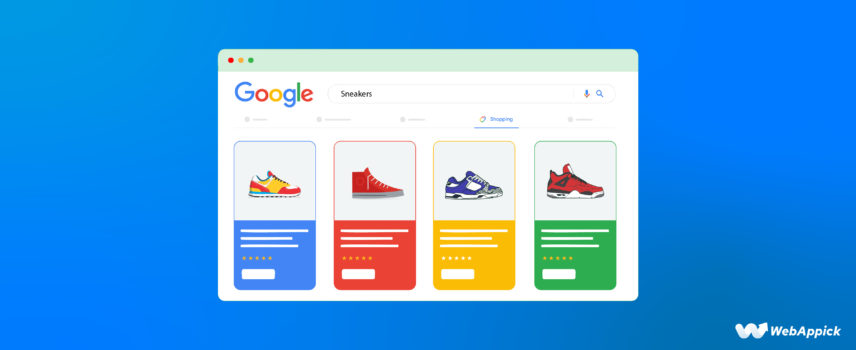
How To Set Up Google Shopping SEO For WooCommerce Store
eCommerce SEO has a mind-boggling ROI (Return On Investment) of 1600% compared to paid promotions.
Yes, you read it right, 1600%!
43% of folks visiting eCommerce sites find them through organic Google searches. Organic traffic refers to the people who find your products on top of Google Search Result Pages (SERP) and visit your store from there.
The sole purpose of SEO is to rank at the top of SERP and earn organic traffic. These free/organic visitors and top ranking can significantly boost your sales and brand reputation.
No wonder search engine result pages have become a battlefield for eCommerce brands, with 64% of marketers putting constant efforts to improve their online stores’ visibility in Google’s search results.
While it is a mighty powerful method for achieving long-lasting success, it’s not easy for a new eCommerce store to do SEO effectively. It’s a journey that requires dedication, learning, and adapting strategies to achieve long-term success.
However, there’s one platform that Google mainly made for eCommerce product promotions that can substantially boost your product rankings and organic traffic. If you haven’t heard of it yet, it’s Google Shopping.
Google Shopping can almost automatically enhance your SEO performance without needing any additional effort. Yet, mastering the specifics of Google Shopping SEO is vital for effective optimization.
To optimize SEO for Google Shopping, you first need to learn what Google Shopping is and how it works.
In this article, we will explain Google Shopping and walk you through how to set up SEO on Google Shopping.
Let’s begin.
How does Google Shopping work?
Before we discuss Google Shopping SEO, it’s very important to understand how the platform works. If you have used Amazon or sites like PriceGrabber, you are already familiar with the idea.
When a shopper searches for the product they need on Amazon, the marketplace returns results from different retailers who have listed relevant products. Then, the shopper can find the best offer and purchase the product.
Google Shopping works almost similarly. However, it is a price comparison shopping engine, a search engine primarily for finding and comparing products.
People use a price comparison engine to find the best deals. When they decide to buy and click on the product, it redirects them to the retailer’s website to complete the purchase.
But Google Shopping is way more than just a price comparison engine. We have discussed this in detail on woocommerce Google shopping interaction.
What makes Google Shopping special is it’s not limited to just the platform; it displays your products all over the internet, be it SERP, YouTube, Gmail, Maps, Images, or any Google-partnered websites.
The greatest thing about this platform is you can free-list your WooCommerce product.
Therefore, Google Shopping is an incredibly powerful platform to reach a wider audience, improve overall search ranking, and increase conversion and brand value.
As a WooCommerce retailer, you can list your products on the platform and grow your business.
Without any further discussion, let us show how Google Shopping displays product results.
Google Shopping explained with example
Let’s say a customer is searching for a” black hoodie.” Like any other shopper, they will start their search on the Google Search Engine Result page or what we commonly know as the Google.com result page.
Here’s how Google SERP may display the result.
Google has integrated Google Shopping into its mothership (Google.com). As soon as someone runs a product search, Google triggers and enables Google Shopping features.
To visit the Google Shopping domain/search results for this particular search, click on the Shopping tab.
This is how Google Shopping displays product results from different retailers.
The platform provides advanced filters to let users refine their search by different attributes.
When the shopper clicks on any individual entry, the platform displays the listing like this –
They can then click on the title to visit the retailer’s site and buy the product.
Along with free listings, Google Shopping is the best platform to run product ads. In fact, it is the number one paid ad medium for products.
Google displays Google Shopping ads in more places than the free listings. Most importantly, Google displays these ads on top of any other content.
Let’s go back to that example and recheck the SERP.
As you can see, Google placed the Shopping ads at the top.
Similarly, on the Google Shopping domain, the ads take the top spot.
Besides these places, Google displays Google Shopping products on different Google platforms and partner sites.
Now, let’s come to the point of how Google Shopping decides which products to display at the top or on the first page. This is where Google Shopping SEO comes into play, which we will cover later in the article.
How to list WooCommerce products on Google Shopping
Other price comparison engines, such as Idealo, PriceGrabber, etc., have their own product management back panel within the main website where you can log in and upload your products. However, Google Shopping doesn’t have a direct product management admin panel on the main domain.
As you know by now, Google distributes your Shopping products across the web. For that distribution, it has a separate platform called Google Merchant Center.
You must upload your products on this platform through a Google Shopping product data feed.
A product data feed is an export file that contains product data in bulk amounts.
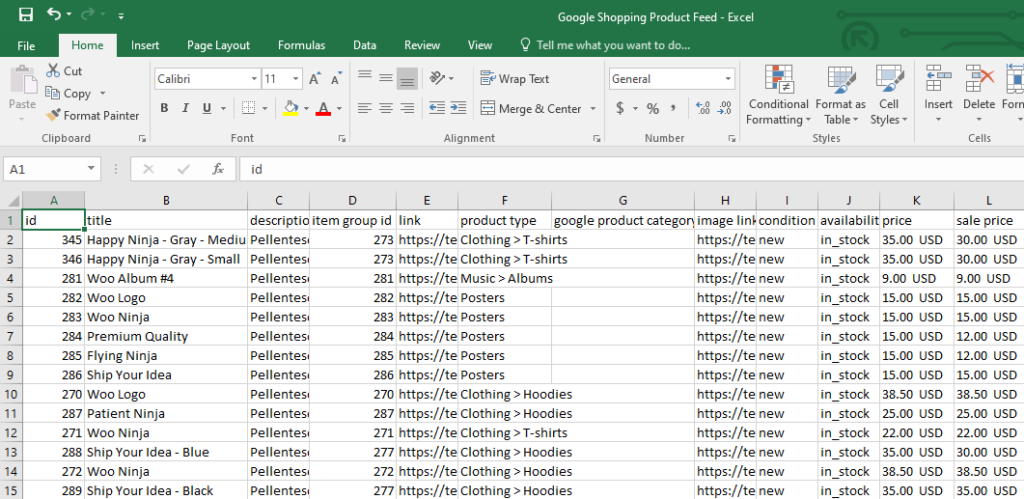
A product feed will include all your product information under all possible characteristics, such as product title, price, description, link to images, product page, categories, etc. These characteristics are known as attributes of a product feed.
GMC (Google Merchant Center) will fetch your Woo products from the feed and distribute them on Google Shopping and all other platforms we mentioned earlier.
Therefore, you need to optimize this feed for Google Shopping SEO.
Creating a feed manually causes loads of errors and will get exceptionally challenging doing SEO for Google shopping. Hence, you must use a product feed management tool such as CTX Feed.
Through this plugin, you won’t need to do any manual labor, not even for Google Shopping SEO. If you have done SEO on your WooCommerce product pages, the plugin will fetch those optimizations and include them on the feed automatically.
Learn the full WooCommerce Google shopping integration.
The product feed is the most important element in the process of Google Shopping listings. This feed holds the data Google will display on Google Shopping and other sites.
Therefore, you need to optimize this feed for Google Shopping ranking.
Let’s discuss what elements you need to optimize.

Google Shopping SEO tips for WooCommerce store
Similar to standard page SEO, you need to optimize your Google Shopping listings for search engines so they can rank top and reach the organic audience. The better your Google Shopping optimization, the higher the likelihood of ranking and appearing on relevant searches.
As we have already mentioned, you need to optimize your product page elements for SEO and create a data feed that includes all those data. Besides the regular optimizations, there are some specific optimizations you can perform to better rank your products on relevant searches.
In the following segments, we will discuss critical elements/characteristics/attributes you can optimize for Google Shopping SEO or Google Shopping ads SEO.
Google Shopping product title optimization
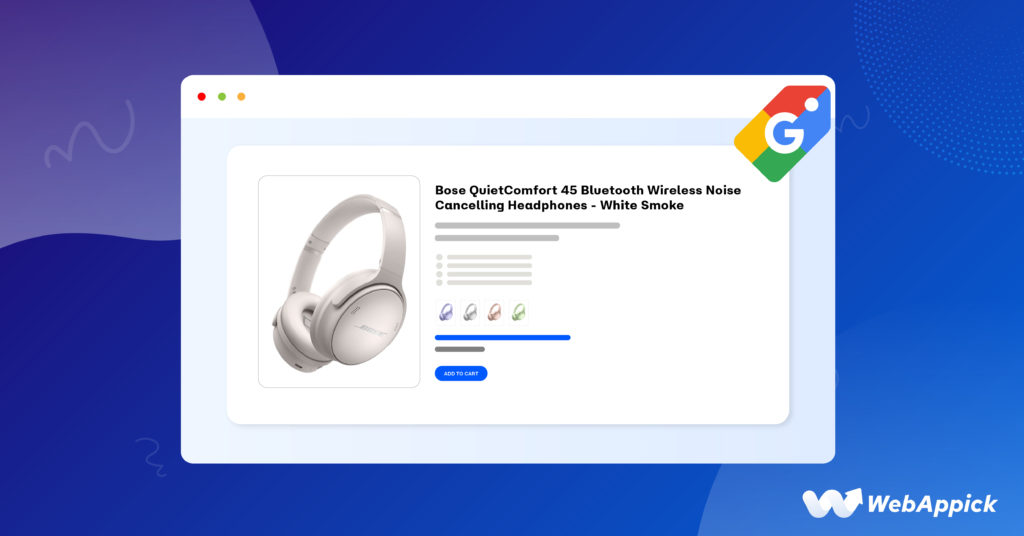
Product titles play a crucial role in Google Shopping SEO, influencing both product visibility and click-through rates (CTR). Optimizing these titles requires a strategic approach that balances keyword inclusion, user clarity, and adherence to Google’s guidelines.
Importance of product titles:
- Product discovery: Google primarily relies on product titles to understand your product and how it matches search queries.
- Relevance: Optimized titles increase the chances of your product appearing in relevant searches, driving more qualified traffic.
- Click-through rate (CTR): Clear and compelling titles entice users to click, leading to higher conversion rates.
Key strategies for optimization:
- Keyword research: Identify relevant keywords that accurately describe your product and align with user search terms. Utilize keyword research tools like Google Keyword Planner and SEMrush.
- Keyword placement: Prioritize high-volume, relevant keywords at the beginning of your title. Google primarily considers the beginning of the title for matching search queries.
- Specificity: Include important product details like brand, model number, color, size, material, and unique features. This improves relevance and helps users quickly identify the desired product.
- Clarity and conciseness: Aim for titles between 50 and 70 characters. Be clear and direct, avoiding jargon and excessive abbreviations.
- Action verbs: Use strong action verbs to encourage clicks, such as “Shop now,” “Get yours,” or “Try today.”
- Brand consistency: Maintain a consistent naming convention across your product titles for better brand recognition.
- Google Shopping SEO title guidelines: Always adhere to Google’s product title guidelines to avoid disapprovals and ensure optimal visibility.
Common mistakes to avoid:
- Keyword stuffing: Unnaturally forcing too many Google shopping keywords into the title can negatively impact visibility.
- Inaccurate or misleading information: Providing incorrect details will lead to user frustration and potentially impact SEO.
- Excessive capitalization and punctuation: Use punctuation sparingly and avoid excessive capitalization, which can appear spammy.
- All caps or lowercase titles: Use proper title case for better readability.
- Ignoring Google Shopping guidelines: Violation of guidelines can lead to product disapproval or account suspension.
Product Descriptions Optimization for Google Shopping SEO
Product descriptions play a crucial role in Google Shopping SEO, serving two essential functions: informing both Google and potential customers about your product’s features and benefits.
By optimizing your product descriptions, you can improve your product’s visibility in search results and increase click-through rates (CTR), ultimately leading to higher sales.
Importance of product descriptions
- Enhanced product understanding: Google uses product descriptions to understand the features and benefits of your product, enabling it to match them with relevant search queries.
- Improved user experience: Clear and informative descriptions give users the information they need to make informed purchase decisions, reducing product returns and boosting customer satisfaction.
- Increased conversion rates: Compelling descriptions that highlight key benefits and address user concerns can encourage users to click “Add to cart” and complete their purchase.
Key strategies for optimization
- Target relevant keywords: Research and include high-volume, relevant keywords throughout your description. However, avoid keyword stuffing and prioritize natural language flow.
- Focus on benefits: Highlight the key benefits and features of your product, addressing user pain points and demonstrating how your product solves them.
- Use strong action verbs: Encourage users to take action, such as “Shop now,” “Learn more,” or “Try today.”
- Write for your audience: Use language that resonates with your target demographic, avoiding jargon and technical terms they may not understand.
- Maintain a conversational tone: Write as if you were talking directly to the user, making the description engaging and informative.
- Structure and readability: Break up long descriptions with bullet points, headings, and images for improved readability.
- Optimize for mobile: Ensure your descriptions are easily read and navigated on mobile devices.
- Include relevant information: Don’t forget to include essential details like product dimensions, materials, warranty information, and shipping details.
- Unique and accurate: Avoid copying descriptions from other sellers or manufacturers. Ensure your descriptions are accurate, and original, and reflect your product’s unique value proposition.
Common mistakes to avoid
- Keyword stuffing: Unnaturally stuffing keywords into your description can negatively impact Google’s ranking and readability.
- Inaccurate or misleading information: Providing incorrect details can lead to user frustration and potentially impact SEO.
- Poor grammar and spelling: Ensure your descriptions are free from grammatical errors and typos for a professional and trustworthy appearance.
- Lack of clarity and conciseness: Keep your descriptions concise and to the point. Avoid using overly technical language or excessive jargon.
- Ignoring mobile users: Ensure your descriptions are optimized for mobile devices, with responsive formatting and easy navigation.
Google Product Category for Google Shopping SEO
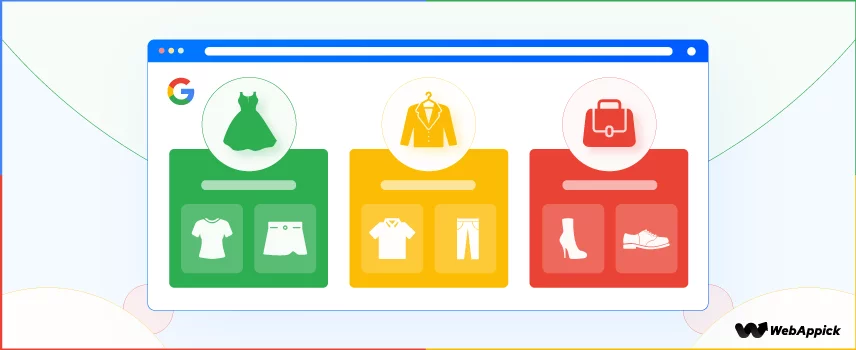
A Google Product Category is a standardized classification system used by Google to organize products listed on Google Shopping. It provides Google with a clear understanding of your product and helps them match it with relevant search queries.
Importance of Google product categories for SEO
Choosing the right Google Product Category is crucial for your Google Shopping SEO for several reasons.
- Improved product visibility: Accurate categorization ensures your product appears in relevant search results, increasing its exposure to potential customers.
- Enhanced product understanding: Google uses product categories to determine the context and meaning of your product, allowing for better matching with user searches.
- Accurate tax calculation: Google uses product categories to calculate the appropriate tax rate for your product in certain jurisdictions.
- Compliance with Google Merchant Center guidelines: Using the correct product category is essential for complying with Google’s guidelines and avoiding product disapprovals.
Choosing the right Google product category
Here are some key points to consider when selecting the appropriate Google Product Category:
- Specificity: Choose the most specific category that accurately describes your product. This helps Google understand the exact nature of your offering.
- Match with product title and description: Ensure your chosen category aligns with the information provided in your product title and description.
- Hierarchy: Google’s product category structure is hierarchical. Choose the most relevant sub-category within the broader category that best fits your product.
- Consider your target audience: Consider how your target audience might search for your product and choose a category that reflects those search terms.
- Use Google’s resources: Google provides a comprehensive Product Taxonomy Guide and Product Category Reference Guide to help you choose the correct category.
Tips for optimizing Google product categories
- Research your target audience: Understand how they search for similar products.
- Use a combination of categories and attributes: You can specify additional attributes within your chosen category to refine your product’s classification further.
- Review and update your categories regularly: As your product inventory or Google’s taxonomy evolves, ensure your categories remain accurate and relevant.
- Utilize automation tools: Consider using tools like CTX Feed to automate your product categorization process and ensure consistency across your product listings.

Common mistakes to avoid
- Choosing the wrong category: Selecting an inaccurate category can lead to decreased product visibility and inaccurate tax calculations.
- Using generic categories: Be specific and avoid generic categories like “Other” or “Miscellaneous.”
- Ignoring category updates: Google’s product taxonomy may change over time. Stay informed and update your categories accordingly.
- Inconsistency: Maintain consistency in your product categorization across all platforms and channels.
Product image optimization for Google Shopping SEO

Google Shopping Product images are crucial for SEO, influencing not only product visibility but also click-through rates (CTR).
High-quality, Google shopping-optimized images enhance the user experience and provide valuable information to Google about your products.
Importance of Product Images
- First impression: Images are the first thing users see, making them a powerful tool for attracting attention and influencing purchase decisions.
- Enhanced product understanding: Images provide visual information that words alone cannot convey, helping users understand the product’s features and benefits.
- Improved click-through rates (CTR): High-quality, relevant images are more likely to entice users to click on your product listing, leading to higher conversion rates.
- Increased product visibility: Google considers image quality and relevance when ranking your product in search results.
Key strategies for optimization
Image quality
- High resolution: Use high-resolution images (at least 800×800 pixels) for clear and detailed product representation.
- Proper lighting: Ensure good lighting accurately reflects the product’s color and texture.
- Clean background: Use a simple, clean background that does not distract from the product.
- Multiple angles: Showcase the product from various angles, including close-ups of important features.
- Zoom functionality: Allow users to zoom in on the product for a closer look.
Image relevance
- Focus on the product: Ensure the product is the central element of the image, occupying a significant portion of the frame.
- Remove distracting elements: Avoid including logos, watermarks, or promotional text on the product image itself.
- Highlight key features: Use close-up images to highlight specific features and benefits of your product.
- Accurate representation: Ensure the images accurately reflect the color, size, and other characteristics of your product.
Technical aspects
- File size: Optimize image file size for faster loading times without compromising quality.
- File format: Use Google-recommended image formats like JPEG, PNG, or BMP.
- Image names: Use descriptive file names that include relevant keywords for improved search engine visibility.
- Alt text: Provide accurate and descriptive alt text that describes the product image for accessibility purposes and helps search engines understand the content.
Common mistakes to avoid
- Using low-quality images: Blurry, pixelated, or poorly lit images can negatively impact user experience and SEO.
- Misleading or inaccurate images: Images that do not accurately represent the product can lead to customer dissatisfaction and returns.
- Excessive use of text: Avoid placing text directly on product images, which can affect readability and SEO.
- Ignoring mobile users: Ensure your images are optimized for mobile devices with fast loading times and responsive formatting.
Product feed optimization for Google Shopping SEO
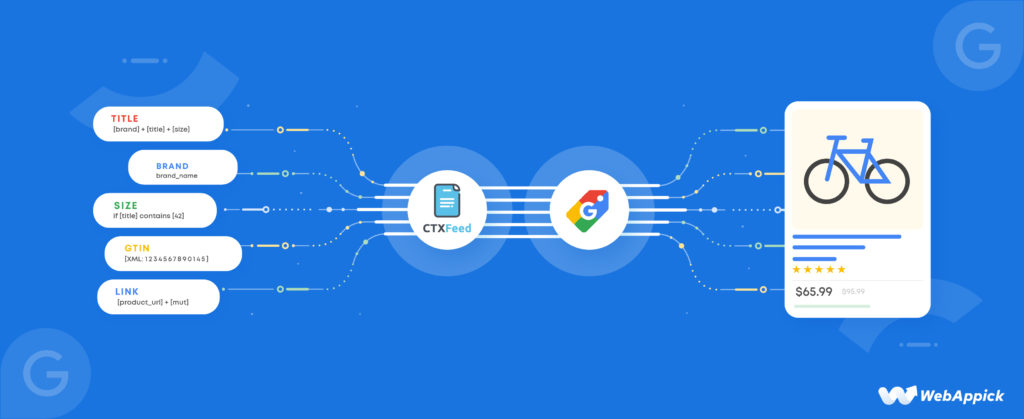
A Google Shopping Product Feed Optimization is the foundation for success. It provides Google with the necessary information to understand your products, match them with relevant search queries, and display them prominently in search results.
Key strategies for optimization
Data completeness and accuracy
- Ensure all required attributes are included: Google Merchant Center requires specific product attributes like product title, description, image URL, price, and GTIN. Missing or inaccurate information can lead to disapproval.
- Maintain data consistency: Ensure consistency between your product feed and your website or other online platforms.
- Regularly update your feed: Keep your product information up-to-date, including changes in price, availability, and inventory.
Product information optimization
- Use relevant keywords: Integrate relevant keywords throughout your product titles, descriptions, and other attributes to improve search visibility.
- Highlight benefits and features: Focus on the key benefits and features that differentiate your product and entice customers.
- Use clear and concise language: Avoid jargon and technical terms your target audience may not understand.
Feed structure and format:
- Follow Google’s feed specifications: Adhere to Google’s product feed specifications for proper formatting and data structure.
- Utilize appropriate data types: Ensure each attribute value is formatted correctly, using the appropriate data type (e.g., text, number, date).
- Validate your feed: Utilize Google’s Merchant Center feed validation tools to identify and address any errors or inconsistencies.
Additional optimization tips
- Utilize custom labels: Create custom labels to categorize your products by specific attributes, allowing for targeted advertising and promotions.
- Optimize mobile experience: Ensure your product feed is optimized for mobile devices, with fast loading times and responsive formatting.
- Leverage automation tools: Utilize tools like CTX Feed- Woocommerce Product feed to automate feed management tasks, saving time and reducing errors.
- Track and analyze performance: Monitor key metrics like impressions, clicks, and conversion rates to identify areas for further optimization.
Common mistakes to avoid
- Incomplete or inaccurate data: Missing or incorrect information can lead to product disapproval and hinder visibility.
- Keyword stuffing: Unnaturally stuffing keywords can negatively impact Google’s ranking and user experience.
- Ignoring mobile optimization: Poor mobile experience can decrease clicks and conversions.
- Neglecting feed validation: Failing to validate your feed can result in errors and product disapprovals.
- Ignoring performance tracking: Without monitoring performance, you may miss opportunities to improve your results further.
Wrap up
Google Shopping is a monster of a marketing channel to boost organic traffic, reach a massive audience, and grow your online store business. However, in order to beat your competition and rank top of Google Shopping search result pages, you need to have an effective SEO strategy in place.
Hope this Google Shopping SEO guide will help you optimize your products for the platform efficiently and achieve optimum results.
